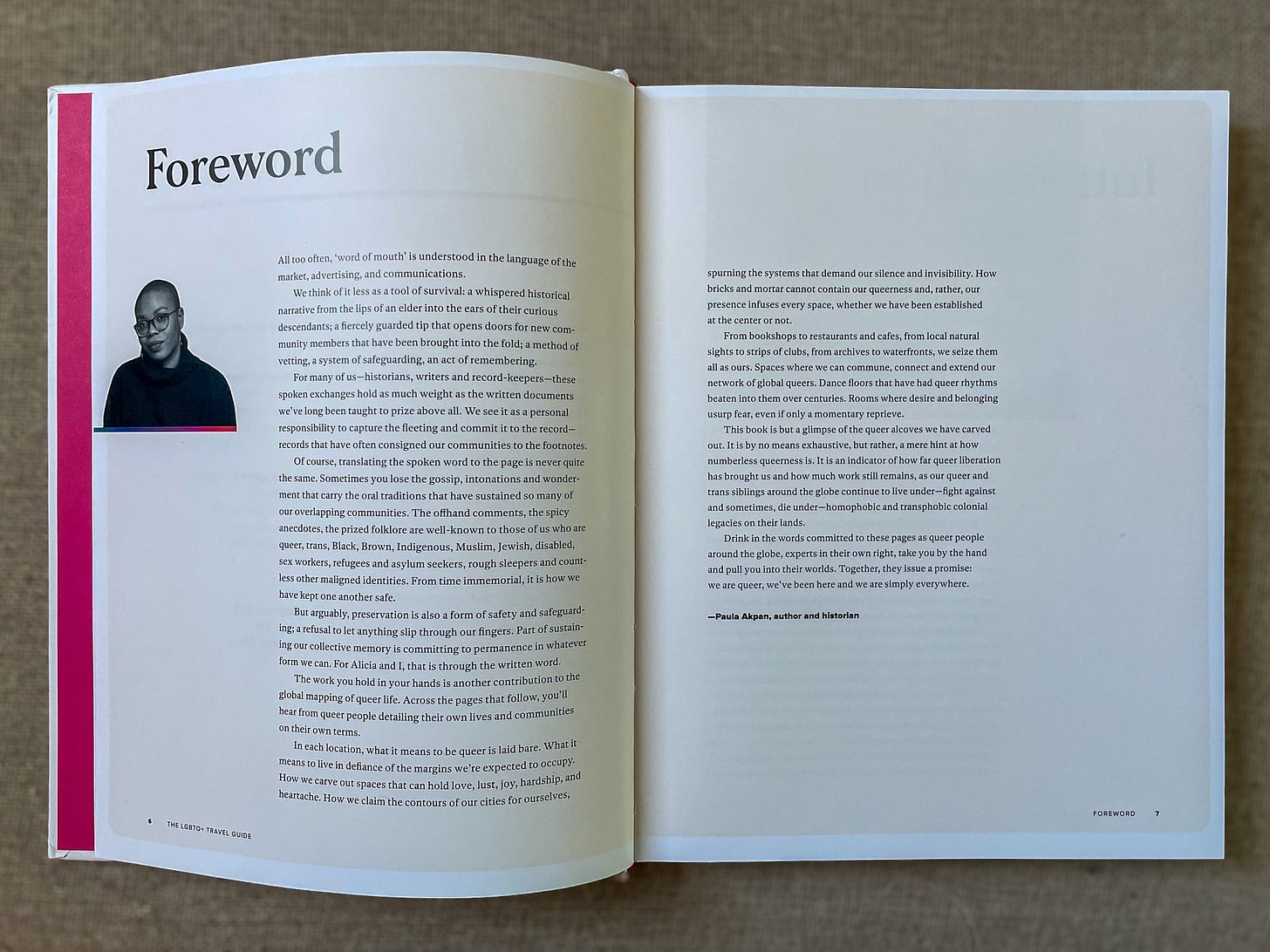Around this time last year, I was wrapping up final edits on my manuscript, and I was starting to think about who might be the right fit to introduce the book to readers.
Those of you with copies of the book will already know this but spoiler: I tapped author and historian Paula Akpan to write the foreword for The LGBTQ+ Travel Guide for Lonely Planet.
Here’s how it happened—and why I’m so glad it did.
Why I thought of Paula for the book’s foreword
I’ve been a fan of Paula’s writing ever since our time at Her Campus overlapped between 2012 and 2015 during my undergrad years. I remembered her as one of the first HC writers to tackle topics about trans women and intersectional feminism before anyone else at the publication even seemed to be having those conversations. I was inspired by her work then, and I continue to be today.
I was impressed by the work Paula has done in the LGBTQ+ travel space (case in point: when I reached out to her, she was in the midst of crowdfunding for The Black Queer Travel Guide app, the building of which is still in progress as far as I understand) and thought it really resonated with the mission of this book, i.e. celebrating and exploring queer-friendly travel spots across the globe through the stories of LGBTQ+ locals who actually live there.
How I asked if Paula would be open to writing the foreword
I was confident that Paula’s perspective would not only enrich the book but also help us reach more readers who could truly benefit from her expertise and insights, and I told her as much—and added that her involvement in this project would be a dream come true, so my goal would be to make the process as easy as possible and to be respectful of her time. Here’s the pitch I sent her:
“If you’re open to lending your voice to the foreword for this book, I’d love to send you a copy of the proposal to offer context for initial consideration, and then a copy of the manuscript once complete. I want to make sure you have the space to really make it your own without it being too much of a hassle, so I’d offer something like a timeframe of 3-4 weeks (or more if you need it) to read through it and write the foreword (usually only about 500-1,000 words) in a way that feels authentic to you as well as to the global LGBTQ+ travel community.”
How we sorted out the foreword logistics
Paula got back to me with a thoughtful message (“who knew Her Campus would be the starting point for so many of us!”) noting her excitement about the book and how deeply needed it was at this precise moment in the world. She said she was honored to be considered to write the foreword and would love to learn more and she asked me to pass the proposal along to her, which I did.
I heard back from her agent the next day who requested a few clarifications: whether the timeline was still as suggested in my original email (yes), if Paula would be offered a fee for the foreword (yes, of course), and how I envisaged Paula being credited (however she felt most comfortable), as well as whether there would be any paperwork she'd need to take a look at (yes, there would be a standard contract to sign).
I worked through these details with her agent directly until all parties were satisfied, then we were in business.
The process of actually writing the foreword
Paula followed up with me to share her initial thoughts about how she planned to approach the foreword:
“I'm a huge fan of the idea and looking forward to this book being out!
I think one thing I will probably mention in the foreword is how we, as Westerners, frame what is 'safe' and 'queer-friendly' in the rest of the world, while the UK and North America are becoming increasingly hostile states for our trans siblings to exercise their rights and have access to resources. I think that kind of acknowledgement is key, alongside how issues of legality ultimately shape what and where we consider 'safe' i.e. if I can get married to my partner there, does it truly make it safe for me to be visibly read as queer? How much does policy and legislation signal a shift in societal attitudes? Lastly, it would be very, very important to root an introduction in the legacies of colonialism and the criminalisation of homosexuality and expressions of what we call queerness today.
It's a lot, but I'll hopefully find a way to make all this fit while introducing the book! How does this sound to you? I'll wait to read the manuscript first, but those are the first percolating ideas.”
I touched base with my own agent and the team at Lonely Planet to confirm that they were on board with this plan as well, and I replied to Paula with the following:
“As far as your initial thoughts around what you'd like to include in the foreword, that all makes total sense to me! I checked in with the team at Lonely Planet to make sure they were aligned as well, and they agreed that as long as you are going to tie that in with travel, they're okay with it, too. They did note that they don’t want it to read like a history paper or argument, but rather like an op-ed that showcases your experience in and perspective on traveling while queer.
As they put it, the foreword can certainly be backed up with the legacies of colonialism and criminalization of homosexuality, but that should be background rather than the focus. Basically, they're super excited about your expertise; they just want to make sure the main focus will be introducing the book and what there is to appreciate in the book! Does that make sense and align with what you had in mind, as well?”
Paula was receptive to that feedback, so as soon as the manuscript draft was complete, I sent it her way to read so it could inform how she’d approach writing the book’s foreword.
A few weeks later, she passed along the draft for her foreword, along with her headshot and how she’d like to be credited. After some very light-touch revisions from my editor at Lonely Planet, she was sent the final version of the foreword copy to approve, and we were all set!
The final result: The most beautiful foreword I could have hoped for
All too often, ‘word of mouth’ is understood in the language of the market, advertising, and communications.
We think of it less as a tool of survival: a whispered historical narrative from the lips of an elder into the ears of their curious descendants; a fiercely guarded tip that opens doors for new community members that have been brought into the fold; a method of vetting, a system of safeguarding, an act of remembering.
For many of us—historians, writers, and record-keepers—these spoken exchanged hold as much weight as the written documents we’ve long been taught to prize above all. We see it as a personal responsibility to capture the fleeting and commit it to the record—records that have often consigned our communities to the footnotes.
Of course, translating the spoken word to the page is never quite the same. Sometimes you lose the gossip, intonations, and wonderment that carry the oral traditions that have sustained so many of our overlapping communities. The offhand comments, the spicy anecdotes, the prized folklore are well-known to those of us who are queer, trans, Black, Brown, Indigenous, Muslim, Jewish, disabled, sex workers, refugees and asylum seekers, rough sleepers, and countless other maligned identities. From time immemorial, it is how we have kept each other safe.
But arguably, preservation is also a form of safety and safeguarding; a refusal to let anything slip through our fingers. Part of sustaining our collective memory is committing to permanence in whatever form we can. For Alicia and I, that is through the written word.
The work you hold in your hands is another contribution to the global mapping of queer life. Across the pages that follow, you’ll hear from queer people detailing their own lives and communities on their own terms.
In each location, what it means to be queer is laid bare. What it means to live in defiance of the margins we’re expected to occupy. How we carve out spaces that can hold love, lust, joy, hardship, and heartache. How we claim the contours of our cities for ourselves, spurning the systems that demand our silence and invisibility. How bricks and mortar cannot contain our queerness and, rather, our presence infused every space, whether we have been established at the center or not.
From bookshops to restaurants and cafes, from local natural sights to strips of clubs, from archives to waterfronts, we seize them all as ours. Spaces where we can commune, connect, and extend our network of global queers. Dance floors that have had queer rhythms beaten into them over centuries. Rooms where desire and belonging usurp fear, even if only a momentary reprieve.
This book is but a glimpse of the queer alcoves we have carved out. It is by no means exhaustive, but rather, a mere hint at how numberless queerness is. It is an indicator of how far queer liberation has brought us and how much work still remains, as our queer and trans siblings around the world continue to live under—fight against, and sometimes, die under—homophobic and transphobic colonial legacies on their lands.
Drink in the words committed to these pages as queer people around the globe, experts in their own right, take you by the hand and pull you into their worlds. Together, they issue a promise: we are queer, we’ve been here, and we are simply everywhere.
—Paula Akpan, writer and historian
Read more of Paula’s writing!
If you just got chills reading that like I did, then great news: Paula just published an incredible book of her own entitled When We Ruled: The Rise and Fall of Twelve African Queens and Warriors, which I cannot recommend highly enough and which you can order for yourself here if you’re in the UK or here if you’re in the US.
And! You can read more of Paula’s written works on Contently on topics ranging from Blackness and queerness to arts and entertainment and beyond, and you can find her at @paulaakpan to follow along with her advocacy and adventures on social media.






